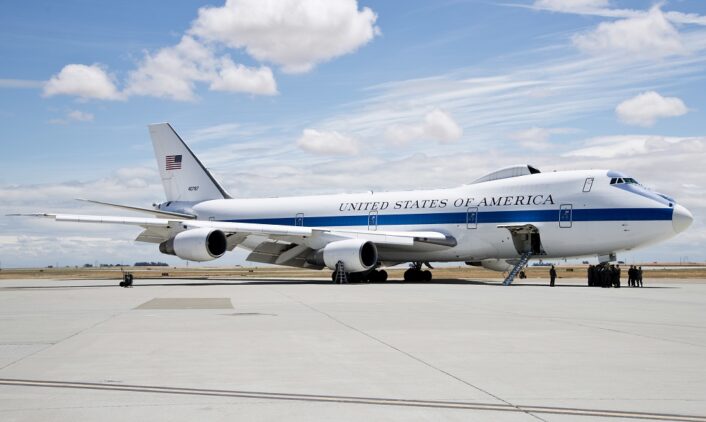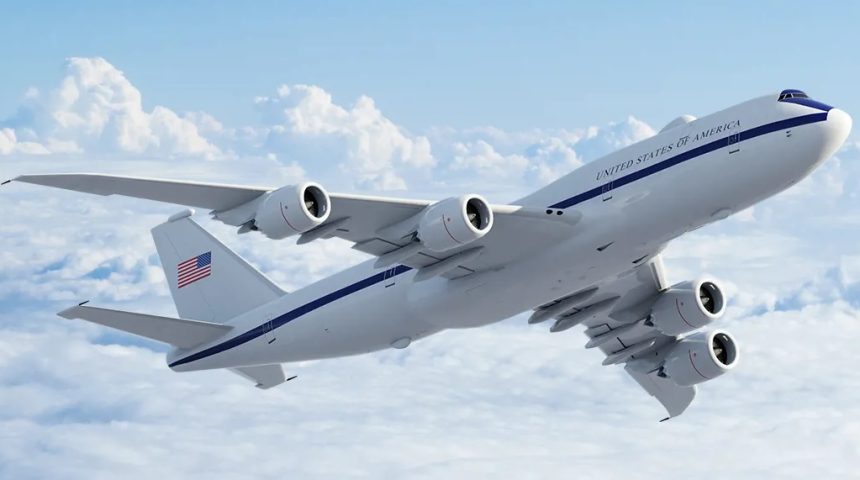The new commercial derivative aircraft will replace the 1970s’ E-4B Nightwatch in the National Emergency Airborne Command Post role.
Sierra Nevada Corporation has been awarded a contract, worth more than USD 13 billion, for the Survivable Airborne Operations Center (SAOC), the replacement for the U.S. Air Force E-4B Nightwatch, also known as the “Doomsday” plane. Details are currently scarce, limited only to the ones divulged in the contract notice.
So, let’s start from the contract notice released by the Department of Defense:
Sierra Nevada Corp., Englewood, Colorado, was awarded a $13,080,890,647 cost-plus-incentive-fee, fixed-price incentive (firm-target), and cost-plus-fixed-fee contract for the Survivable Airborne Operations Center (SAOC). This contract provides for the development and production of the SAOC Weapon System to include the delivery of engineering and manufacturing development aircraft, associated ground systems, production aircraft, and interim contractor support. Work will be performed in Englewood, Colorado; Sparks, Nevada; Beavercreek, Ohio; and Vandalia, Ohio, and is expected to be completed by July 10, 2036. This contract was a competitive acquisition, and two offers were received. Fiscal 2024 research, development, test, and evaluation funds in the amount of $59,000,000 are being obligated at time of award. The Air Force Life Cycle Management Center, Hanscom Air Force Base, Massachusetts, is the contracting activity (FA2834-24-C-B002).
The award to Sierra Nevada Corporation was already expected after Boeing confirmed it was no longer competing for the SAOC contract in December 2023. This also represents one of the largest contracts assigned to the company, which in the past has already worked on the Air Force’s A-29 Super Tucano, M-28 Special Operations aircraft, C-130s, as well as the Army’s Athena ISR program.
Similarly to the E-4B, the new SAOC will be a specialized variant of a commercial derivative aircraft, which the company has reportedly chosen but not announced yet. One of the possible options could be the Boeing 747-8 as, according to some reports, the requirements ask for a four-engine aircraft. The only problem is that the Boeing 747 production ended last year, so the Air Force will have to acquire used aircraft if it ends up being the chosen aircraft.
“To satisfy operational requirements, the weapon system will be comprised of a Commercial Derivative Aircraft that will be hardened and modified to meet military requirements,” said an Air Force spokesperson to Breaking Defense. “The development of this critical national security weapon system ensures the Department’s Nuclear Command, Control, and Communications capability is operationally relevant and secure for decades to come”.
The new aircraft will be hardened against electronic and nuclear attack, while incorporating secure communications, self-protection systems, air refueling capability, and a modular open systems approach that will allow rapid upgrades to further improve the aircraft’s capabilities. The number of aircraft to be delivered is not known, however some reports say the Air Force plans to buy 8-10 aircraft for the SAOC fleet.

The E-4B Nightwatch
The E-4B is a modified B747-200 that serves as National Airborne Operations Center (NAOC) providing a flying command, control and communications center to direct nuclear (and conventional) forces, by receiving, verifying and relaying EAM (Emergency Action Messages). Four E-4B are in service with the U.S. Air Force and operated by the Air Force Global Strike Command out of Offutt Air Force Base, Nebraska. One aircraft is usually airborne every 12 hours, with another one ready for departure with a 5-minute notice.
The E-4B, designed to carry the U.S. SecDef as well as other U.S. top officials and always supporting Air Force One’s trips abroad, is specifically designed to keep American decision makers alive in case of nuclear wars, crisis, zombie invasions or alien attacks. Therefore, it has to be able to fly through any EMP (electromagnetic pulse) with unharmed systems. That’s why this highly-modified Boeing 747 does not feature modern glass cockpit but old fashioned, analogue-style avionics are more resilient to EMPs.
The E-4B is protected against the effects of electromagnetic pulse and has an electrical system designed to support advanced electronics and a wide variety of communications equipment. An advanced satellite communications system provides worldwide communication for senior leaders through the airborne operations center. Other improvements include nuclear and thermal effects shielding, acoustic control, an improved technical control facility and an upgraded air-conditioning system for cooling electrical components.
According to the U.S. Air Force fact sheet, the Nightwatch aircraft’s main deck is divided into six functional areas: a command work area, conference room, briefing room, an operations team work area, communications area and rest area. An E-4B may include seating for up to 112 people, including a joint-service operations team, Air Force flight crew, maintenance and security component, communications team and selected augmentees.









